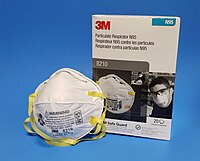
Photo from wikipedia
Abstract Throughout the COVID-19 pandemic, hundreds of millions of people worldwide have become new users of respiratory protective devices. Facemasks and KN95 respirators utilizing an ear loop straps system (ELSS)… Click to show full abstract
Abstract Throughout the COVID-19 pandemic, hundreds of millions of people worldwide have become new users of respiratory protective devices. Facemasks and KN95 respirators utilizing an ear loop straps system (ELSS) have recently become popular among occupational and non-occupational populations. Part of this popularity is due to the ease of wearability as compared with traditional devices utilizing two headbands, one worn over the head and the other behind the neck—a universal strap system used in NIOSH-certified N95 filtering facepiece respirators (FFRs). Some users convert the two-strap configuration to an adjustable ELSS. The first objective of this pilot study was to quantitatively characterize how such a conversion impacts the respirator fit. Additionally, a novel faceseal (NFS) technology, which has been previously demonstrated to enhance the fit of N95 FFRs, was deployed to modify the ELSS-converted N95 FFRs. The second objective of this study was to quantify the fit improvement that results from adding the NFS to the ELSS. The study was conducted by performing the Occupational Safety and Health Administration (OSHA)-approved quantitative fit testing (QNFT) on 16 human subjects featuring different facial shapes and dimensions. Three models of cup-shaped N95 FFRs were tested in three versions: the standard version with manufacturer’s strap system, the ELSS-converted, and the ELSS-converted version modified by adding the NFS. QNFT demonstrated that the fit of an N95 FFR featuring the traditional/standard headbands strap system is negatively impacted when this system is converted to an ELSS. The fit of an ELSS-converted respirator can be significantly improved by the addition of the NFS. We found that the FFR model and the strap system version are significant factors affecting the QNFT-determined respirator fit factor (FF), as well as the OSHA QNFT pass rate (FF ≥100). The findings suggest that the current NFS, if further improved, has a potential for developing a ‘universally fitting’ ELSS-equipped N95 FFR that can be used by the general public, the vast majority of whom do not have access to OSHA fit requirements.
Journal Title: Annals of Work Exposures and Health
Year Published: 2022
Link to full text (if available)
Share on Social Media: Sign Up to like & get
recommendations!